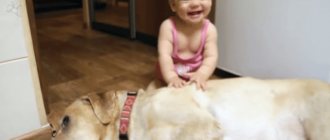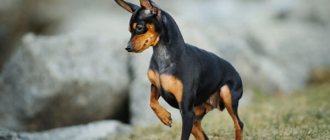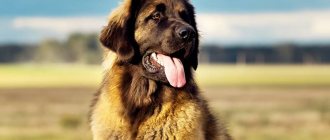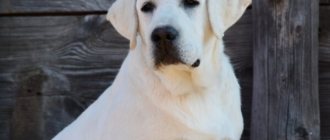A breed that has been included in the list of hero dogs, shared the pedestal of popularity with the Golden Retriever, and has received monuments and honors is the Labrador Retriever. An excellent all-round worker, an intellectual, a loyal and devoted pet until his last breath, he gradually conquered the world and firmly established himself in the rankings of favorite breeds. Despite its overwhelming popularity, the history of the breed is shrouded in darkness, there are no proven facts, only versions exist.
Breed traits
Breed traits (on a 5-point scale)
| Labrador Retriever | |||
| Activity | in the house | 3.4 | |
| on the street | 4.4 | ||
| Obedience | training | 4.2 | |
| strangers | 4.2 | ||
| Domination | in family | 1.8 | |
| over dogs | 2.4 | ||
| Defending your territory | from people | 2.2 | |
| from dogs | 2.5 | ||
| Sociability | in family | 4.9 | |
| with strangers | 4.1 | ||
| with dogs | 3.7 | ||
| Concentration | in family | 1.1 | |
| in front of strangers | 1.6 | ||
| with dogs | 1.6 | ||
| Aggressiveness | in family | 1.2 | |
| to strangers | 1.8 | ||
| to the dogs | 2.2 | ||
| to cats | 2.2 | ||
| Family behavior | calmness | 4.6 | |
| demand for affection | 4.6 | ||
| excitability | 3.6 | ||
| playfulness | 4.5 | ||
| excessive barking | 2.6 | ||
| behavioral breakdowns | 2.7 | ||
| Tolerance for children | up to 4 years | 4.4 | |
| over 4 years old | 4.6 | ||
| Institutional use | watchman | 3.7 | |
| bodyguard | 1.9 | ||
This breed is often compared to the following dog breeds: German Shepherd, Rottweiler, Beagle, Doberman Pinscher, Cane Corso.
Video
* We invite you to watch a video about the Labrador Retriever . In fact, in front of you is a playlist in which you can select and watch any of 20 videos about a given dog breed by simply clicking on the button in the upper right corner of the window. In addition, the material contains quite a lot of photos. By looking at them you can find out what a Labrador Retriever looks like.
In this article:
|
General characteristics of Labrador
Labrador Retrievers are so called because they belong to the retriever group. They are classified as medium-large breeds, compact in size, but with a powerful build. The height at the withers of an adult male can reach 60 cm, but the weight of Labradors is no more than 35 kg. With proper care they live 12-14 years.
Labrador puppy
This breed is popular all over the world. Not only ordinary dog breeders, but also professional dog handlers consider her the most obedient, devoted, hardworking and smartest. Anyone can have such a pet, since the price of even purebred puppies is low.
The advantages of these dogs
This is one of the few large dogs that are suitable for living in an apartment. They are unpretentious and easily adapt to any conditions. But the Labrador breed also has many other positive qualities:
- they are friendly, not at all aggressive, loyal;
- sociable, but balanced and calm;
- love children, can become an ideal nanny for a baby;
- easy to teach, as they are smart and quick-witted, they understand not only words, but also intonation;
- very playful and active, always ready to play, support the owner in everything;
- flexible, live quietly in the same house with other pets;
- efficient, hardy;
- unpretentious, do not require special care, except for the molting period;
- They are distinguished by a beautiful exterior and artistry, so they always attract attention.
Disadvantages of the breed
But before you get a Labrador Retriever, you need to know about its disadvantages. There are few of them, they are easily corrected by proper upbringing. Many dog breeders call this breed ideal, but Labradors have the following disadvantages:
- clumsy, like to chew on everything, so things in the house may get damaged;
- very active, you need to walk a lot with them;
- loving, good-natured and trusting, joyfully greeting all people, can jump on strangers;
- They have an insatiable appetite, they pick up everything in sight on the street, they love to beg, therefore they are prone to obesity;
- Labradors are not suitable for a small apartment due to their rather large size;
- cunning and intelligent, if trained incorrectly, can manipulate the owner;
- They shed twice a year and very heavily.
Who are they suitable for?
The Labrador Retriever is suitable for keeping in any home. It can be kept both in an apartment and in a private house in the yard. In the latter case, he needs a warm, spacious enclosure. But this pet does not tolerate loneliness, and also does not have protective qualities, so most often Labradors are kept in the house.
Fawn Labrador
This breed is suitable for any people, even those inexperienced in keeping animals. A family with a child should have them, as they love children very much and will never offend them, no matter what they do. These pets easily adapt to the habits and lifestyle of the owner and find a common language with all family members.
But due to its activity and energy, this breed is not suitable for homebodies or people leading a sedentary lifestyle, because they need to be walked a lot. They are worth getting for athletes, hunters, and travelers. The pet will accompany its owner everywhere; this breed is ideal for agility, bike joring, freestyle, and enjoys catching Frisbees and running after a stick.
Labradors are ideal guide dogs. They are easy to train, intelligent and friendly. They become the best companions for the disabled, guides for the visually impaired, and friends for children with socialization problems. This breed is most suitable for canistherapy - a method of treatment and rehabilitation with the help of animals.
Labrador on a walk
Labradors are often used in police service because these dogs have a very sensitive sense of smell. They easily find drugs, explosives, and missing people. But they cannot guard the territory or detain a criminal, since they have absolutely no aggression.
A description of the characteristics of a guide dog, how they are raised and how important they are for blind people can be seen in the video.
Interesting Facts
Labrador dogs are very popular, but most dog owners know them only as loyal companions. Although these animals have an interesting history, and a lot of unusual things can be told about them.
- The breed is called a Labrador Retriever, so they are often identified with Golden Retrievers. But these are two different breeds, differing both in appearance and behavior. Unlike the Labrador, Golden Retrievers have one color option, longer coats, and a graceful build.
- The Labrador is the best swimmer among dogs. Thanks to its webbed feet and specially shaped tail, it easily floats on the water, moves quickly and dives well. And the special waterproof double wool allows you to swim even in cold weather.
- Labrador is classified as a service breed, but not because of its protective qualities. They do not have a sense of their own territory or aggressiveness towards strangers, but they have great efficiency, devotion and obedience.
- Labradors are dogs that are almost insensitive to pain. Thanks to these qualities, they are ideal for rescue work, searching for missing people, and police work. They have a very sensitive sense of smell, which allows them to be used to search for drugs.
- The great thing about the Labrador Retriever is that he can easily control his jaw muscles. This dog will never bite a person, even by accident. They can carry a raw egg in their mouths without damaging it. Therefore, for families with children, the Labrador is an ideal pet. But he loves to chew on everything; he can eat furniture, linoleum, and shoes.
- These pets become mature late, they act like puppies until they are 4 years old. But even as an adult, the Labrador will be playful and mischievous. These are very positive dogs, cheerful and good-natured.
- Previously, Labradors were called St. John's dogs or small Newfoundlands. This is due to the history of the origin of the breed.
Receptivity to training
As mentioned above, Labradors are very easy to train and have a high level of intelligence. Some difficulties may arise solely through the fault of the owner, who does not always take into account some of the impulsiveness of his pet. We give the floor to the experienced and train his brain so that there is no time to be distracted by extraneous stimuli. Under no circumstances should you shout or even hit the dog. Rough physical force is the worst thing you can think of. This is a bad way to earn your dog's respect and the fastest way to lose his trust. This way the Labrador will only develop fear, and not an understanding of what you want from him.
If you manage to interest the dog and show him who is boss in the good sense of the word, then he will definitely not be bothered by outrages like picking him up from the ground, wallowing in all sorts of nasty things, and having a tight leash.
In general, the Labrador has three weaknesses: children, food and water. If a Labrador sees a puddle on the street, it will dive in head over heels. In such cases, we recommend being proactive: if you see a puddle, distract the dog’s attention (for example, with the “twist” command) and choose a different way around,” explains Marina Radostnaya.
History of Labradors
This breed has a short history; it appeared only in the 19th century. Breeding was carried out in the UK, although the birthplace of Labrador retrievers is Canada. These efficient dogs were also called small Newfoundlands, as they were common on this island. There they helped fishermen and hunters. The history of origin is still unclear: either the British brought a ready-made breed to Europe, or they took out its ancestors and started breeding them in Great Britain.
Labrador
The origin of the name is also unclear. According to one version, the Spaniards named the dogs this way, since labrador translates as “hardworking.” According to another version, these dogs originate from the island of Labrador. There is also an option that they were named so because of their black shiny wool, reminiscent of the labradorite stone.
At the end of the 19th century, the British presented the first black Labradors at an exhibition. 1870 is the time of the birth of the breed. A few years later, the first standard was approved, according to which only black dogs were recognized. Two more varieties of Labrador color became standard only at the end of the 20th century. Labradors in fawn, chocolate, and white colors are now popular.
Labrador mouth
In Russia, the breed began to be bred only in the 70s. After one Labrador was brought to Moscow, interest in them arose. But due to the lack of fresh blood, they were first crossed with Newfoundlands. Only since the mid-90s did they begin to meet international standards. Nowadays there are many kennels operating in Russia, the dogs from which take prizes at international exhibitions and live with dog breeders all over the world.
What documents are needed
Get a referral for mating from the kennel club in advance. Make an agreement with the instructor. Discuss all the details and conditions with the owner of the dog so that there are no disagreements later. The owner of the dog himself sets the price for mating. Cheap prices can only be if the dog does not have titles and high ratings.
All participants sign the mating act. They confirm the Labrador identification and date. Both first and control mating. Photocopies of the owners’ passports and pedigrees of the retrievers are attached to the document. If the dog is from a kennel, attach a copy of its registration certificate. All documents from canine exhibitions are also needed.
How to prepare a Labrador for breeding: photo.
Breed standard
Now there are two types of standards: English and American, in accordance with them, two varieties of the breed are distinguished. Although these dogs began to be imported to America from Europe only in the 20th century. Most breeders use the international standard adopted in 2011.
Labrador with a ball
According to it, the height of an adult male is 56-57 cm, but the height at the withers is acceptable up to 60 cm. The size of the female is slightly smaller. Their height does not reach more than 54-56 cm. Weight is not regulated by the standard. But it is desirable that for adult girls it should be 25-32 kg. The weight of boys can be more - 29-36 kg.
Frame
From the photo you can see that the Labrador has a strong build, compact and harmoniously built. The back is wide, with a straight topline. The loin is short and muscular. The chest is deep and wide.
The body is slightly elongated and has a rectangular format. The withers are well defined, the belly is not sunken and has dewlap. The tail is very thick at the base, tapering towards the end. It is heavy, which helps you move freely through the water.
Head
The head is proportional and large. The muzzle is wide, not sharp. The transition from the forehead to the nose is well defined. The ears are medium, triangular, close to the body. They are set far on the sides of the head and slightly behind.
Head
The eyes are dark, but may be yellow. The nose and lips should be dark. The jaws are strong and powerful. But any photo shows that the dog’s facial expression is good-natured and inquisitive.
Limbs
The limbs are well developed and harmonious. The front are straight, with long shoulder blades and elbow. The hock joints are set low. The paws are compact, rounded, and the toes are arched. Thanks to this structure, the movements are wide, free, light, the front and hind limbs move in parallel.
Wool
The Labrador's coat is short, very thick and smooth. It is tough, but pleasant to the touch. The peculiarity of the undercoat is that it is very thick, dense, and waterproof. This allows the pet to swim in any weather and not freeze in winter, but molting causes problems for the owners.
Color
Colors: black, fawn, chocolate
These dogs have only one color. Sometimes a small white spot on the chest is allowed. Labrador retrievers come in several colors.
- Black Labradorite is the most common option. It was with this color that the breeding of the breed began. The black color should be rich and shiny; a small white spot on the chest is acceptable. Such dogs are non-marking, look impressive, but they don’t look very good in photos.
- Later, brown dogs appeared. All colors from light to dark are allowed. There are chocolate and liver color options. Chocolate Labrador has become more popular in recent years. His eyes can be yellow or brown.
- Fawn-colored Labrador Retrievers are also common. This color was recognized at the beginning of the 20th century. Fawn Labrador can have several types: golden, cream, fawn with chocolate pigmentation. This color looks elegant and attractive.
Varieties
Chocolate Labrador
There are English and American types of Labradors. The American one appeared later; it is distinguished by a more graceful physique, compact size and light bones. The English standard describes a working dog with a large head and muscular limbs. These pets are described as easy to train, obedient and hardworking.
For more information about the characteristics of the English and American type of breed, you can watch the video:
Grooming
Labradors are quite unpretentious and do not require special care. Their fur does not tangle and does not require frequent brushing. Natural lubrication gives it water- and dirt-repellent properties. It is impossible to say that the dog will not get dirty at all, but there will be no difficulties in washing it. In most cases, it is enough to wipe your pet with a damp towel. Frequently washing an animal with shampoo is not recommended at all, so as not to disturb the natural protective layer, unless it is soiled with something strongly “fragrant”.
Healthy dogs shed profusely 2 times a year, when the coat changes before the new climatic season: autumn and spring. There are ways to speed up this process, for example using a special comb - a furminator, but it is impossible to get rid of it completely. If a Labrador sheds all year round, then most likely this indicates disturbances in the animal’s nutrition.
Nails need to be trimmed as needed, but more often they wear down on hard surfaces during a walk, except for the dewclaws. The dog's ears and eyes should be clean and free of foreign odors. The presence of discharge may indicate errors in nutrition or the presence, for example, of a fungal infection, which is the task of a veterinarian to determine.
photo from the personal archive of Marina Radostnaya /
Description of the Labrador's character
The main characteristics of this dog are good nature, playfulness, balance and cheerfulness. They can infect everyone with their optimism. The peculiarity of the pet's character is its loving nature and friendliness towards everyone. Combined with his lack of aggression, this makes him completely unsuitable for the role of a security guard.
Labradors in nature
Another character trait is intolerance to loneliness. The pet's need is to be close to the owner, serve him and obey him. In terms of devotion and fidelity, the Labrador has no equal. But for this reason, he cannot be kept in an enclosure or on a chain, or left alone for a long time.
Genetically, the nature of the Labrador breed includes the need to bring prey to the owner. Without proper upbringing, he can hunt birds, pick up and bring various objects on the street. These dogs love water, so lying in a puddle is considered a fun activity.
Features of training Labradors
Training this dog will not be difficult even for an inexperienced dog breeder. These dogs are so intelligent and obedient that they learn simple commands quickly. They remember and understand several hundred phrases that are often spoken in their presence.
Chocolate color
In addition to the basic course, Labradors can be trained in more complex ways. It is easy to teach them to fetch a stick, a ball, or catch a disc. These pets are suitable for canine sports and love to run with their owner. They are happy to learn; it is best to use praise, affection or treats in training. You should not use punishment or even beat your pet; he understands the strict tone.
Without proper upbringing, a Labrador can become touchy and disobedient. Without communication with a person, he gets bored, gets sick and becomes depressed.
How many live at home?
The lifespan of a Labrador is 10-14 years . How many years your pet will live largely depends on nutrition, maintenance and care.
To read: Fashionable sentence for dogs clothes and muzzle for French bulldogs
Balanced food, constant exercise and exercise, examinations by a veterinarian, a friendly attitude - all this can guarantee a healthy and long, within normal limits, life for your four-legged friend.
Most dog breeders are confident that the more obese a Labrador is, the shorter it will live . In many cases, dogs that are lean and fit actually live longer. So if you want your pet to live a long life, then you should monitor its diet, keep it on a special diet and give only high-quality food.
Labrador: maintenance and care
In order for a dog to live a long time and delight all family members with its cheerful disposition, it needs to be provided with proper care. For a loving owner this will not be difficult. But to avoid problems, you need to accustom your Labrador puppy to hygiene procedures as soon as he appears in the house. With proper care, life expectancy will be at least 12 years.
These animals are unpretentious and can be kept in a city apartment. The main condition is to ensure sufficient physical activity. You need to walk with your pet for at least 3-4 hours a day, preferably so that it moves actively. These dogs love water very much, so if possible, you need to take them to a river or lake.
Puppy with kitten
The rules of care are no more complicated than for other pets. After a walk, you need to wipe your paws, trim your nails regularly, and examine your eyes and teeth. You need to be more careful with your ears - they are droopy and often get dirty, which can lead to inflammatory diseases.
A difficulty for some owners is the long-term shedding of their pet. He has a lot of undercoat, and by the time he changes everything, there will be fur all over the house. To avoid this, you need to thoroughly comb your pet every day at this time. The rest of the time, it is enough to comb it once a week.
Thanks to its special properties, the pet's fur cleans itself. Therefore, it does not need frequent washing. Most veterinarians, when asked how long to bathe a pet, answer that 2-3 times a year is enough. The exception is the fawn colored dog. Light fur quickly becomes dirty, and dark spots form around the eyes and ears, as well as on the paws.
Feeding
It is best to feed your pet dry food. If you buy super-premium or holistic options, it will be provided with all the necessary nutrients. Dry food is balanced; usually, this feeding does not require additional vitamin supplements. The main thing is to correctly calculate the amount, since these animals are prone to obesity. It is better to consult a veterinarian, they have a good appetite and can overeat.
Puppy
When feeding natural food, it will be difficult to provide your pet with all the necessary substances. It is important to correctly create a diet, determine how many times he should eat and what portion. Many people are interested in whether it is possible to give a Labrador chicken and vegetables, this is allowed. Sweets are prohibited for him, especially chocolate, pasta, pastries, onions, potatoes, pork, raw fish, chicken bones.
Diseases
Labradors have several diseases that are more common than others. The most common is obesity. These dogs gain excess weight quickly, especially if you don’t watch their diet. To avoid this, you need to consult your veterinarian about how many hours a day your pet needs to run. It is usually recommended to walk for 2-4 hours.
Color black
Atopic dermatitis is common in these dogs. But this disease can also be kept under control by watching your diet. But diseases such as cataracts, osteochondrosis, hip dysplasia in a pet can be congenital.
For more information about what you need to buy for a Labrador puppy and how to provide him with good conditions, you can watch the video:
MATING OR BREEDING
After selecting sires and clarifying the timing of ovulation, the female is delivered to the male for mating. For hygienic reasons, you should first make sure that your partners do not have infectious or other genital diseases, which will reduce the risk of infection through sexual contact (for example, herpesvirus in dogs). To do this, it is necessary to follow the rules of preventive hygiene - regular cleaning of the dog bed, washing the floors, and promptly carry out serological control in order to avoid the consequences of using antiseptics, which often have a toxic effect on sperm, being one of the reasons for unsuccessful fertilization.
Mating of Labradors begins immediately after a short phase of play and sniffing, they increase the excitement of the partners. An erection ensured by the hardness of the penis bone and the flow of blood to the penis bulb makes it possible to insert it into the female genitals. This causes the female's vagina to contract, allowing sperm to rise and maintain an erection, as well as keep the penis in the vagina during ejaculation.
The duration of this phase should be at least 5 minutes, but it can last more than half an hour if the bitch’s movements help tighten the bulb of the penis. In most cases, if the right moment is chosen, the partners themselves cope perfectly with the task, and you should not disturb them with your presence. Discreet observation from a distance (or through a video system) is usually sufficient to ensure mutual acceptance of the partners and that the mating has taken place. It should be noted that mating without a lock can also result in fertilization, although fertility usually decreases.
Even with complete confidence in the correct determination of the time of ovulation, it is still advisable to repeat the mating after 48 hours. The risk of a bitch being impregnated by different males is very significant, therefore, in order to avoid a situation where puppies in the same litter have different fathers, it is better to isolate the bitch until signs of estrus completely disappear. Superfetation (fertilization during pregnancy) was not observed in dogs.
Some owners leave their bitches in the dog's habitat for several days after signing the breeding contract. This contract can be drawn up on the basis of an international regulation adopted by the FCI in June 1979. The rental agreement regulates the conditions under which the breeder surrenders the bitch to a third party and receives the puppies during the post-weaning period.
If, for various reasons, mating of the chosen partners naturally turns out to be impossible, it becomes necessary to resort to artificial insemination.
How to buy
It is better to purchase a dog from a specialized nursery. Pedigree Labrador puppies cost from 15 to 30 thousand rubles. The cost of show class pets reaches 60 thousand. Before contacting a kennel, you need to study reviews about it, prices, photos of dogs.
Puppies
One of the problems when choosing a novice dog breeder is the gender of the pet. Girls are calmer and more obedient. They only have problems with the opposite sex twice a year during estrus. Boys are more active and efficient, inquisitive, and persistent. But they can mark territory.
If you buy a puppy through an advertisement or on the market, it will be cheaper. The price of a dog without a pedigree is 5-10 thousand. But there is no guarantee that the pet will be purebred, healthy and without character flaws.
Judging by the reviews, the Labrador has more advantages than disadvantages. Many believe that this is the best companion, friend and assistant in everything. It is not for nothing that this breed is used as guide dogs and rescuers. She has a genetically inherent desire to serve people. Their love for children and inability to bite humans make them ideal pets for families with children.
Health
The average lifespan of a Labrador Retriever is 10–12 years. The relatively short lifespan can be explained by the rather high propensity of the breed to cancer. Unfortunately, the main disadvantages of the breed are the work of humans; the rapidly growing popularity of Labradors in the modern world has had a negative impact on genetics. A successful choice of a puppy is a 50% guarantee of raising a healthy pet. Do not trust spontaneous sellers; only large nurseries and reputable breeders will be able to provide you with data on the pedigrees of the parents and hereditary diseases of the line.
Diseases typical for the breed can be combined into a fairly short list, but it is worth understanding that for a Labrador the risk of falling victim to a disease is quite high:
- Hip dysplasia and arthrosis of the knee joints - both ailments can be hereditary or age-related. In a mild form, the dog suffers from lameness; in a severe form, it experiences severe pain and is unable to walk. There is no complete treatment. As an alternative, an operation is proposed, during which the head of the joint is cut down, extended, inserted into the joint sac and fixed until new cartilaginous tissue grows.
- Progressive retinal atrophy is a pathology that leads to loss of vision in the dark, and then to complete blindness. The disease is painless, diagnosed during an eye examination, is inherited or acquired.
- Oncological diseases - lymphoma, angio- and lymphosarcoma, mastocytoma and mastocytosis.
- Atopic dermatitis - manifests itself as a rash, itching, the formation of scales and minor skin lesions. The disease is autoimmune in nature, that is, the dog’s immune system mistakenly attacks the skin.
- Epilepsy is a neurological disorder that occurs both as a result of DNA disorders and as an independent phenomenon. It manifests itself as trembling, spasms, convulsions, a condition that the animal cannot control. In attacks, the four-legged dog may swallow its tongue, choke on saliva, or suffer a heart attack. The consequences are unpredictable, and there is no effective treatment.
Black
These dogs usually have dark brown eyes and black pigment on the nose, around the mouth and around the eyes. They have a clean, smooth and shiny coat. They are especially popular among hunters, but can also be used for exhibition. Aging black dogs are easier to identify than others because the gray patches around the muzzle are clearly visible against their coat.
Genes responsible for the black and brown color of a dog
The information that determines whether a Labrador will be black or chocolate is passed on through a pair of genes:
- One of them is the large B gene (this is the dominant gene), which causes black fur.
- There is also a small b (this is a recessive gene) that causes a brown or chocolate coat.
This leaves three different combinations of genes that a Labrador can inherit from its parents (one from each):
- BB
- Bb
- bb
Why is black the most common color? Because gene B, which is responsible for this color, is dominant. It is normal for dominant genes to turn off or ignore recessive genes.
- A dog with BB genes will be black because it does not have the small b gene that produces brown fur.
- A dog with Bb genes will also be black because if the dominant black gene is present, it will turn off the recessive one.
- Accordingly, only an individual with bb genes will be chocolate.
More clearly
Generation after generation of black Labradors can give birth to black puppies
One gene is taken from each parent's dog
Until two individuals with a small b gene meet
In case of bb genes the dog is chocolate colored
Genes responsible for the yellow color of a dog
But, there are times when a dog with the BB or Bb genes will not be black. And when a dog with bb genes will not be brown. There is another pair of genes that is responsible for the yellow color. Genes E and e. Accordingly, also dominant and recessive.
These genes have a different power. They have power over the B and b genes and can displace black and chocolate. Its small genes are able to influence or, in some cases, “turn off” the B and b genes.
- Large gene E (dominant), does not affect color.
- The small e gene (recessive) can mask or turn off the B and b genes, which would otherwise give us black or brown coloration. But this is only true if there is no dominant gene E, as we discussed above, it turns off the recessive gene.
Each individual inherits one of these genes, resulting in three possible combinations:
- E.E.
- her
- Ee
Only in the case of ee genes will the Labrador be yellow.
It turns out that we have three pairs of genes:
- E.E.
- her
- Ee
- BB
- Bb
- bb
Silver
Silver Labradors are the most controversial in the purebred world. The controversy surrounding this type of Labrador comes from the color of their coat. Some argue that it was a hidden gene that showed itself years later when two Labradors with the same recessive d gene finally produced a litter of puppies.
Corresponding set of genes:
- Eebbdd
- EEbbdd
Others argue that the gene resulted from a cross with another dog (possibly a Weimaraner) carrying the recessive gene. Or it was a genetic mutation. At the moment, it is still not clear what the true reason for their appearance is.
Varieties of genotypes
The table below lists the possible varieties of genotype and phenotype (genotype is a set of genes, phenotype is appearance).
| Gene set | Color |
| EEBB | Black |
| EEBb | Black |
| EEbb | Brown |
| EeeBB | Black |
| EeBb | Black |
| Eebb | Brown |
| eeBB | Yellow |
| eeBb | Yellow |
| eebb | Yellow |
Breed genetics more clearly











